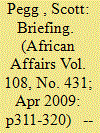|
|
|
Sort Order |
|
|
|
Items / Page
|
|
|
|
|
|
|
| Srl | Item |
| 1 |
ID:
085991


|
|
|
|
|
| Publication |
2008.
|
| Summary/Abstract |
Between 22 April and 6 May 2008, Sudan's fifth population and housing census was conducted in both North and South Sudan. Because it will have a decisive impact on future power and wealth sharing in Sudan, the census has been highly contested, and its outcome is likely to be controversial. Will the census enhance future stability in the Sudan? Or will it turn out to be a stumbling block and cause for further conflicts?
This briefing argues that the hotly contested census not only highlighted existing tensions between the North and the South on topics such as resources, power sharing, and identity but also intensified competition among Southern Sudanese political actors. The census, an immense logistical undertaking, mobilized the major political actors who seek to use it instrumentally in their own interest. It also created high expectations among the population about the future provision of services and development.
Under the provisions of the 2005 Comprehensive Peace Agreement (CPA) signed between the Sudan People's Liberation Movement/Sudan People's Liberation Army (SPLM/A) of Southern Sudan and the (Northern) National Congress Party (NCP), the census is supposed to pave the way for the planned 2009 general elections as well as the referendum in 2011 in which Southerners will decide about independence from the rest of Sudan.
In 2005, after 21 years of war between the North and the South, the two main parties in the conflict - the SPLM/A and NCP - signed the CPA, which ended armed hostilities. The vision of then SPLM/A rebel leader John Garang, who died in a helicopter crash a few months after the signing, was not an independent South, but a united 'New Sudan'. In terms of the CPA's power-sharing agreement, the SPLM, the political wing of the SPLA, became a partner of the NCP at the national level in the Government of National Unity (GoNU). In the South, the SPLM dominates the autonomous Government of Southern Sudan (GoSS), which was established with independent executive, legislative, and judiciary bodies based on the CPA.
|
|
|
|
|
|
|
|
|
|
|
|
|
|
|
|
| 2 |
ID:
087724


|
|
|
|
|
| Publication |
2009.
|
| Summary/Abstract |
THE LARGEST SINGLE PRIVATE SECTOR INVESTMENT in sub-Saharan Africa, the Chad-Cameroon Petroleum Development and Pipeline Project, attracted worldwide attention not for the size of its oil reserves or the technical complexities of constructing a 1,070-kilometre pipeline from southern Chad to Cameroon's Atlantic coast, but for the elaborate World Bank-sponsored capacity-building initiatives designed to ameliorate the seemingly damaging 'resource curse' effects that oil production has had in other sub-Saharan African countries such as Angola, Equatorial Guinea, Nigeria, and Sudan.1 The project ran into trouble long before the oil started flowing in 2003 as construction activities rapidly outpaced the institutional capacity-building initiatives designed to ensure that Chad actually used its forthcoming oil revenues for poverty alleviation. Throughout 2005 and 2006, as it dealt with a myriad of domestic and international political crises, the government of Chad also engaged in a series of disputes with both the World Bank and members of the oil consortium (ExxonMobil, Petronas and Chevron) that culminated in the formal ending of the World Bank's role in this project in September 2008.
|
|
|
|
|
|
|
|
|
|
|
|
|
|
|
|
|
|
|
|
|